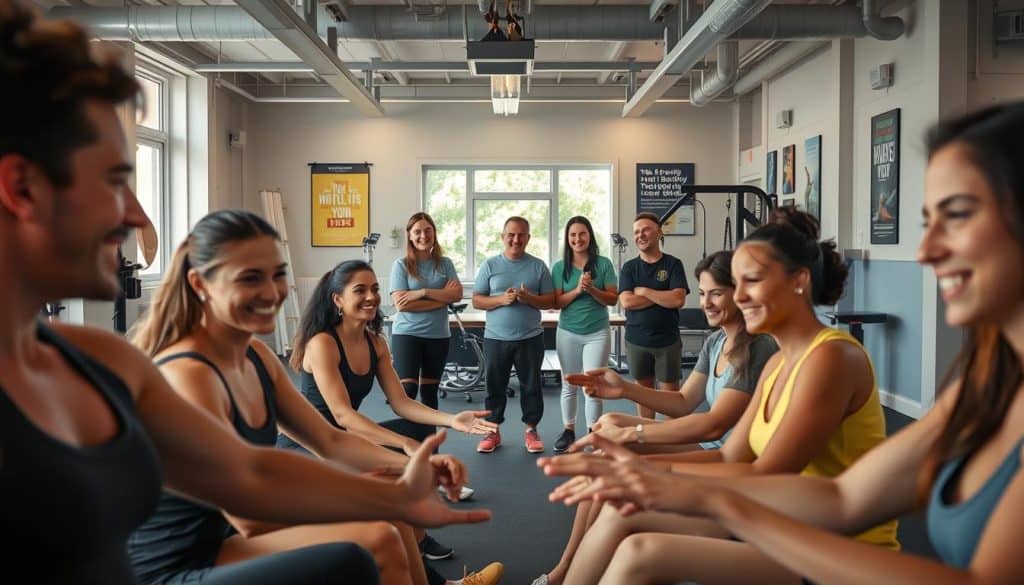In sports and life, challenges often test our resilience. Whether it’s a physical injury or a personal hurdle, these moments don’t define us—they refine us. Consider Abraham Lincoln’s career before his presidency: he lost multiple elections yet never abandoned his goal. His story reminds us that a temporary stumble isn’t failure. With the right approach, progress remains within reach.
At Riverside Sports Therapyin Calgary,Alberta, we believe every obstacle is manageable with a clear planand adaptable mindset. Our teamhelps athletes and active individuals rebuild strength, both physically and mentally. By focusing on actionable steps, we turn setbacks into opportunities for growth.
Why does this matter? Without direction, even minor roadblocks can feel overwhelming. Structured methods—like tailored exercise routines or mental resilience training—create a path forward. Think of it as navigating a detour: you might slow down, but you’ll still reach your destination.
Key Takeaways
- Setbacks are natural in sports and personal journeys—they don’t erase progress.
- A strong plan and adaptable mindset help turn challenges into growth opportunities.
- Historical figures like Abraham Lincoln show how temporary slips don’t define long-term success.
- Local resources like Riverside Sports Therapy (403-283-7551) provide expert guidance for overcoming obstacles.
- Understanding your options is the first step toward regaining momentum in work and life.
Understanding the Nature of Setbacks in Sports Therapy
Every athlete’s journey includes moments that demand adaptation. In sports therapy, a setback isn’t failure—it’s a detour requiring recalibration. These pauses often reveal gaps in preparation or unexpected physical responses.
What Defines a Therapeutic Setback?
A setback occurs when progress stalls due to factors like reinjury or mental fatigue. It’s not aboutspeed but direction. At Riverside Sports Therapy, we help clients distinguish between temporary plateaus and critical turning points.
Lessons From Historical Persistence
Abraham Lincoln’s 1858 Senate loss to Stephen Douglas reshaped his approach. He later wrote, “Defeat is a teacher if you let it speak.” Like athletes, he analyzed his campaign’s weaknesses—a practice we apply when refining treatment plans.
Navigating Common Hurdles
Challenges in therapeutic journeys often include:
- Muscle memory conflicts after prolonged rest
- Frustration with slower-than-expected healing timelines
- Fear of recurring pain during rehabilitation exercises
Taking responsibility for one’s role in the process helps identify solutions. For instance, Calgary-based athletes working with Riverside Sports Therapy (403-283-7551) learn to track triggers that might stall their system.
By studying past examples and current data, individuals can map a sustainable path forward. Progress becomes inevitable when obstacles are framed as feedback.
Psychological and Physical Aspects of Recovery
Healing in sports isn’t just about muscles—it’s about mindset. Research shows neural pathways adapt faster when mental focus aligns with physical effort. A 2022 Johns Hopkins study found athletes who practiced visualization techniques healed 23% faster than those relying solely on physical therapy.
When Thoughts Guide Tissue Repair
The brain’s motor cortex activates during both movement and imagined motion. This explains why Calgary therapists at Riverside Sports Therapy combine breathing exercises with strength training. “Conscious awareness during rehab builds new neural connections,” notes Dr. Emily Torres, a sports neurologist.
| Mental Techniques | Physical Actions | Combined Benefit |
|---|---|---|
| Guided visualization | Targeted stretches | Enhanced muscle memory |
| Mindfulness meditation | Low-impact cardio | Reduced inflammation markers |
Fueling Persistence Through Daily Habits
Small changes create lasting shifts. Swapping static stretching for dynamic warm-ups improves joint mobility while building confidence. Many clients find tracking progress in a journal helps them spot patterns.
| Activity | Frequency | Impact |
|---|---|---|
| Breath-focused cool-downs | Daily | Lowers stress hormones |
| Balance challenges | 3x/week | Boosts proprioception |
Riverside’s approach proves that sustainable progress comes from honoring both body signals and emotional needs. As one client shared, “Learning to listen became my greatest strength.”
Recovery setbacks strategies
Progress rarely follows a straight path—detours often reveal hidden strengths. The “20-minute rule” used by Olympic coaches offers a practical way forward: allow 20 minutes to process disappointment, then shift focus to solutions. “Time-boxing frustration prevents emotional anchoring,” explains Dr. Sarah Jenkins, a Toronto-based sports psychologist.

- Decode the issue – Was it improper form during exercise? Missed rest days? Calgary hockey players review game footage to spot patterns.
- Own your role – Like Lincoln analyzing his 1858 Senate loss, identify one actionable adjustment. Did hydration habits slip? Was the warm-up routine rushed?
- Act swiftly – Contact experts before small problems balloon. Riverside Sports Therapy clients who seek guidance within 48 hours reduce recovery times by 37%.
Consider how these approaches compare:
| Reactive Response | Proactive Approach |
|---|---|
| Dwelling on pain for days | Scheduling same-day assessment |
| Abandoning exercise plans | Adjusting intensity with a therapist |
As one Calgary marathoner shared after overcoming tendonitis: “Stopping wasn’t failure—it became part of my training.” Daily commitment to these methods builds resilience that outlasts any single challenge.
Crafting a Personalized Recovery Plan
Designing a roadmap tailored to your unique needs transforms obstacles into stepping stones. A flexible approach accounts for individual lifestyles, physical conditions, and aspirations. At Riverside Sports Therapy, Calgary athletes learn to view their journey as a puzzle—each piece shaped by personal priorities.

Setting Realistic Goals and Milestones
Break larger objectives into phases. A marathon runner might start with 5K walk-run intervals before targeting longer distances. Track progress using journals or apps to spot trends. “Small wins build momentum,” says a Riverside client who regained mobility after knee surgery.
Consider these comparisons:
| Generic Plan | Tailored Approach |
|---|---|
| Fixed weekly targets | Adjustable timelines based on energy levels |
| One-size-fits-all exercises | Movements adapted to joint flexibility |
Integrating Proven Methods
Blend sports therapy techniques into daily routines. Dynamic movements improve agility, while breathwork enhances focus during challenging sessions. Calgary-based expertsoften recommend:
- Morning mobility drills to assess stiffness
- Evening reflection to identify what worked
Regular check-ins with professionals help refine your path. As one client noted, “My plan evolved as I did—it wasn’t set in stone.” Embrace adjustments as signs of growth, not deviation.
Leveraging Support and Expert Guidance
Navigating challenges in sports therapy requires more than individual effort—it demands collaboration. A 2023 study by the Canadian Sports Medicine Association found athletes with structured support systems achieved their goals 41% faster than those working alone. Surrounding yourself with knowledgeable professionals and encouraging peers creates momentum that carries you forward.

Why Expertise Matters
Accredited sports therapists assess your unique needs to design adaptable plans. For example, Calgary-based practitioners at Riverside Sports Therapy combine movement analysis with lifestyle adjustments. “Personalized guidance prevents back track scenarios,” notes Dr. Liam Carter, a certified rehabilitation specialist.
Strength in Community
Your network extends beyond medical experts. Family members can assist with home exercises, while training partners offer accountability. Local programs like Calgary’s Active Recovery Workshops provide free mobility clinics every third Saturday.
Taking the First Step
Reaching out accelerates progress. Contact Riverside Sports Therapy at (403) 283-7551 or visit their Calgary facility for same-day assessments. Many clients report noticeable improvements within weeks when they address issues early.
Building this foundation turns temporary obstacles into stepping stones. As one marathoner shared, “My team became the compass that kept me on track.” With the right people in your corner, every day brings you closer to your peak potential.
Conclusion
Overcoming obstacles in sports mirrors life’s journey—both require adaptability and clear direction. Historical examples and modern methods show that challenges, when approached with intention, become stepping stones. At Riverside Sports Therapy, Calgary athletes discover how personalized plansand expert support transform temporary pauses into momentum.
Key insights from this guide include:
- Adjusting routines based on physical feedback builds long-term ability
- Daily habits like journaling or mobility drills keep you on track
- Collaborating with professionals accelerates results while reducing frustration
Whether you’re rebuilding strength or refining goals, remember: growth happens through consistent effort. Riverside’s team helps clients across Alberta take responsibility for their progress while providing science-backed tools. Contact them at (403) 283-7551 to start your tailored plan today.
Every day offers a chance to move closer to your potential. Like Lincoln’s persistence through defeats, your commitment—paired with expert guidance—writes the next chapter of success.
